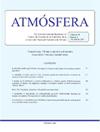用于测量牛肠道甲烷排放的开路呼吸室的准确性评估
IF 1
4区 地球科学
Q4 METEOROLOGY & ATMOSPHERIC SCIENCES
引用次数: 0
摘要
反刍动物是农业部门甲烷排放的主要来源。排放清单和缓解战略需要可靠的测量技术。呼吸室法是一种精确测量牛肠道甲烷排放量的方法。进行了一组实验来验证用于测量牛肠道甲烷排放的两个呼吸室。通过评估分析仪的线性和响应时间、平台可变性和腔室中的高纯度甲烷回收率,对腔室进行了校准,考虑了三个主要组件:甲烷分析仪、空气管道和空气提取系统以及腔室本身。将高纯度甲烷释放到室中后进行的回收率测试计算得出,呼吸室一和二的完整系统的校准系数分别为0.95±0.05和1.03±0.03,相应的不确定度分别为4.87%和2.49%。因此,尤卡坦大学用于牛肠道甲烷测量的呼吸室,墨西哥的功能精确无误。这项技术可用于建立牛的甲烷库存和甲烷缓解策略。本文章由计算机程序翻译,如有差异,请以英文原文为准。
Assessment of the accuracy of open-circuit respiration chambers for measuring enteric methane emissions in cattle
Ruminants are the main source of methane emissions from the agricultural sector. Emission inventories and mitigation strategies require reliable technics of measurement. The respiration chamber methodology is a precise approach for measuring enteric methane emissions in cattle. A set of experiments was carried out to validate two respiration chambers for measuring enteric methane emissions of cattle. The chambers were calibrated considering three main components: the methane analyzer, the air duct and air extraction system, and the chamber itself, by evaluating linearity and response time of the analyzer, plateau variability and high purity methane recoveries in chambers. Recovery test calculations carried out after releasing high purity methane into the chambers gave calibration factors of 0.95 ± 0.05 and 1.03 ± 0.03 for the complete system of respirations chambers one and two, respectively, with corresponding uncertainties of 4.87 and 2.49%. Thus, the respiration chambers for enteric methane measurements of cattle at the University of Yucatan, Mexico function with precision and accuracy. This technique can be used to establish methane inventories and methane mitigation strategies in cattle.
求助全文
通过发布文献求助,成功后即可免费获取论文全文。
去求助
来源期刊

Atmosfera
地学-气象与大气科学
CiteScore
2.20
自引率
0.00%
发文量
46
审稿时长
6 months
期刊介绍:
ATMÓSFERA seeks contributions on theoretical, basic, empirical and applied research in all the areas of atmospheric sciences, with emphasis on meteorology, climatology, aeronomy, physics, chemistry, and aerobiology. Interdisciplinary contributions are also accepted; especially those related with oceanography, hydrology, climate variability and change, ecology, forestry, glaciology, agriculture, environmental pollution, and other topics related to economy and society as they are affected by atmospheric hazards.
 求助内容:
求助内容: 应助结果提醒方式:
应助结果提醒方式:


